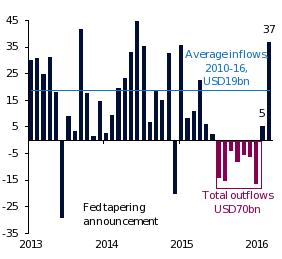Emerging Markets (EMs) experienced a strong capital surge in March, according to the Institute of International Finance (IIF), with the strongest inflows for 21 months. The inflows were broad based across all four major EM regions. EM equity markets have also recovered strongly since the middle of February, rising 14.3% from their lows this year. Does this mean that EMs are now recovering from the slowing growth and capital flight they faced in recent years? We would argue that the EM crisis is not over yet, as the structural challenges facing EMs are likely to persist and recent capital flows are best explained as a bounce back from previous weakness.
Debt and equity inflows to EMs (USD bn)

Sources: IIF and QNB Economics
In the seven months from July 2015, USD70bn flowed out of EMs on concerns about weaker growth amidst the structural challenges of higher US interest rates and slowing growth in China. The outflows peaked in January 2016 at USD16bn, as risk-off sentiment in global financial markets intensified. However, as risk sentiment improved from mid-February, capital began to return to EMs, with USD5bn of inflows in February 2016, then USD37bn in March.
EM equities also crashed in the first few weeks of the year, but then recovered, leaving them only 2.4% up year to date. Some of the larger EMs have performed particularly badly. On a USD adjusted basis, Chinese equities are still down 22% year-to-date and Indian equities are down 12%. Brazil is still down 8% year-to-date, despite a 40% recovery since the middle of February on the prospect that the ruling party may be forced out of government, which is perceived as potentially good for the economy.
EMs are facing two major structural challenges that are dragging on growth and are likely to persist—the tightening of monetary policy in the US and slower growth in China.
The announcement of the tapering of quantitative easing in May 2013 led to higher US interest rates and tighter financial conditions in EMs. EMs have subsequently faced periodic bouts of capital flight, currency depreciation and higher domestic interest rates. Many EMs have high levels of USD debt. Higher US interest rates and weaker EM currencies increased the cost of repaying and servicing this debt, forcing EMs to deleverage. All these factors dragged on growth.
Tighter financial conditions in EMs are likely to persist. The Fed is expected to continue normalizing monetary policy and, as we outlined in a commentary last week, could well raise interest rates more than markets expect. This could lead to further bouts of capital flight, weaker currencies and higher interest rates, holding back a recovery in growth.
The second challenge for EMs is the long-term rebalancing of China’s economy, which is leading to slower growth within China and also impacting global trade. China’s growth has slowed from 10.6% in 2010 to 6.9% in 2015 as the economy has retreated from an excessive debt-fuelled investment drive. China accounts for 30% of EM GDP itself, so the slowdown will directly lead to lower growth in EMs.
Weak demand in China also has a large impact on other EMs, as it has depressed the prices of a number of commodities, negatively impacting commodity-exporting economies which are predominantly EMs. Weaker demand in China has also led to slower growth in EMs that are dependent on China for exports. These factors have also led to deteriorating current accounts, making it harder to finance external debt and further tightening financial conditions. Of the 10 largest EMs, eight have current account deficits, the exceptions being China and Russia.
Slower growth in China is, therefore, likely to be a persistent challenge for EMs. China’s growth is expected to slow to around 6.5% this year based on consensus forecasts. The rebalancing of the Chinese economy from investment and exports towards domestic consumption is a long-term structural change that is likely to continue for some time.
In summary, higher US policy interest rates and slower growth in China in 2016 could continue to create challenges for EMs, leading to volatility in financial markets. The normalization of US monetary policy is likely to be a gradual process, and it will take considerable time to rebalance the Chinese economy. These major challenges will, therefore, make it hard for EM growth to recover in the short to medium-term.
